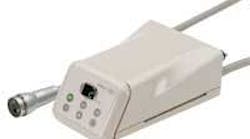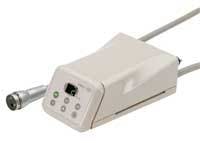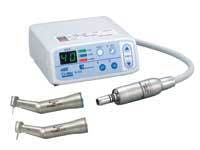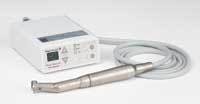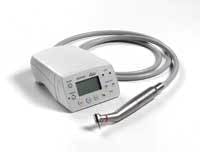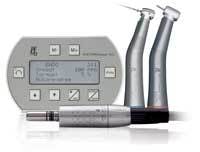There is a strange mystery related to electric handpieces. In Europe and Asia, dentists have embraced this technology for years. These dentists wouldn’t think of going back to air-driven handpieces. The advances in electric handpieces have been driven mainly by European (especially German) dentists. Only in recent years has the electric handpiece been discovered in the United States, even though we have been using electric lab handpieces for years. We are familiar with the constant torque on these handpieces, but somehow it has been slow to transfer to the treatment room.
The most important change to my practice in the past 10 years has been the introduction of the electric handpiece. It has allowed me to do better dentistry for my patients. My tooth preparations are more precise, and done with less noise and vibration - another benefit for the patient. With the latest versions of electric motors and handpieces, the noise level has become less and less - sometimes I check to be sure the bur is turning! Most of my patients comment on the difference in the sound; that it makes their dental experience much better. This low level of sound is of great benefit to the dental team members’ ears. I predict that the dental team of the future will no longer suffer hearing loss due to high-pitched handpieces.
Speed and torque
The most amazing change is constant torque. I can still recall the belt-driven handpiece. It was cumbersome and slow but it did have torque. The switch to air-driven handpieces required a learning curve. We all had to learn a technique that required a “feather touch” to cut tooth structure. This was necessary to allow the handpiece to reach its full speed, which produced greater torque. The torque of the air-driven handpiece has advanced over the years, along with many other improvements.
The electric handpiece has a fully adjustable bur speed, which can be adjusted with a dial or the foot control. The highest bur speed is 200,000 rpm. At this speed, the electric handpiece produces 60 W of cutting power, while an air-driven handpiece running at top speed produces less than 20 W. This simply means that the electric delivers constant torque. The bur will not stop or slow down, no matter what material you are cutting, through all the speed ranges. The electric will still cut tooth structure at 5,000 rpm - try that with an air-driven handpiece.
Forget bur chatter
For years we have all had to deal with bur chatter, especially when cutting through different types of metal, and especially when cutting cast crowns. Have you ever experienced this chatter in your own mouth? I can tell you from my own experience that it is not pleasant at all. As I had a gold crown removed, I realized that this is the same thing my patients feel when I do this procedure with my air-driven handpiece. I remember thinking there must be a better way. Chatter is caused by bur wobble, which is caused by ball bearing wear in the air turbine, which is supported by O-rings. The older the bearings, the more the bur can wobble. The electric handpiece provides greater bur concentricity because electrics rely on solid gear-to-gear contact and rigid bearing support. Therefore, the bur does not wobble, and chatter is eliminated. This results in a truer, more definite cutting instrument, which allows you to routinely produce more precise margins faster with much less effort. In addition, the bur is in contact with the tooth for a shorter time, which means that less heat is produced, which leads to less sensitivity. This function of the electric handpiece is referred to as “milling” as opposed to “chopping” the tooth. The result is a tooth preparation that has smoother walls and more precise margins in less time and with less stress for the dentist and patient. Your patients will love spending less time in the chair!
But aren’t they “heavy”?
A common complaint from dentists of both genders is that the electric handpiece is too heavy; too cumbersome. I have found that it is all a matter of balance and concentration. If you learn to balance the electric motor in the area between your thumb and index finger, you will find that weight is no longer an issue. I know many times I get impatient and unwilling to break through the learning curves to master a technique. But when I have persevered, I was the winner as well as a better dentist. I have watched dentists struggle with the electric handpiece in an exhibit booth. I hand them a tooth and ask them to cut an ideal Class II prep or crown prep. When they are finished, I ask if the handpiece was heavy and, invariably, they say no. In other words, the weight of the handpiece is more of a “head” issue - an issue of perception.
Cut with it
When you visit a booth at a dental show to look at an electric handpiece, the only way to confirm everything I have told you is to try it. Usually there is a piece of bone or a tooth to cut on. Ask for a new diamond, pick up the bone, and sink the bur about a quarter inch (6.5 mm) into the bone and then move it as quickly as you can in different directions. I usually write my name, so if you find “Joe” in the bone, you’ll know I was there. If you are given a tooth, try a crown prep, but instead of shaving the tooth, sink the bur into the enamel about a millimeter and continue around the tooth at that level. Really give the electric a good trial while you are at the booth.
Features to consider
What should you look for when buying your electric handpiece? Most of the head sizes are the same. With the different brands, look for a handpiece that allows you to do all procedures with two handpieces. Look for the best range of speeds on both the high and low speeds. Look for a high-speed range of 1,000 to 200,000 rpm, and a low-speed range of 100 to 40,000 rpm (yes, the bur will still cut at 100 rpm). Your low-speed handpiece also should allow you to do endodontic procedures with torque control and auto reverse. The electric motor should be brushless and sealed to allow for autoclave sterilizing.
The handpiece should have more than adequate air and water spray ports that are easily adjustable. This is important not only for cooling, but also for rapid removal of debris produced by cutting tooth structure and metals. I recommend multiple ports for obvious reasons.
With increased use of extraoral lighting, fiberoptic illumination is becoming less necessary, but it is still a convenient light source. If you include fiberoptics, look for a control system that will allow you to easily turn it off. As you have learned with air-driven handpieces, it is important to have a 360-degree swivel attachment between the handpiece and the hose to eliminate the drag and stress of fighting a hose. When I am prepping teeth, I want the handpiece to feel like it is not attached to anything. Look for this kind of innovation. I know it exists because mine is that way. A quick disconnect feature is very important for the sterilization process. The handpiece should have a push-button chuck for convenient bur changing. You don’t want to be looking for a bur changer or messing with a latch. Be sure to carefully follow the maintenance directions from the manufacturer. Do not shortcut the process! Also, carefully follow the manufacturer specifications for handpiece and motor sterilization including type, temperature, and time.
All electric handpieces are quickly retrofitted to existing units in treatment areas. Simply disconnect an air-driven handpiece from its tubing connector, and then reconnect the tubing connector, which is usually at the back of the electric motor control box. That will transfer air and water to the electric handpiece. Now, place the electric motor in the empty hanger and it is ready to go, operated by the existing foot control on the floor. The setup is very convenient, and in less than five minutes you are ready to go. Look for a remote-control device for the motor control unit that can be conveniently placed near your treatment area.
Some great choices
In alphabetical order, here are some electric handpieces to look at. This list is certainly not intended to be complete. These are electrics that I have tried and liked, or electrics that other dentists have tried and told me they liked. So it is a biased listing.
A-dec: I have not tried this handpiece myself, but have heard many good reports from dentists in my seminars who have had great results with the A-dec W&H system. W&H is a great name in handpieces.
Bien Air: I have had this electric the longest, so I have the most experience with it. I am still using my original handpieces after eight years with no breakdowns or repairs. I like the newest handpieces the best because they are the quieter than my older ones. Be sure to look at the new OPTIMA MX system. This is one of the quietest electrics on the market. It is exciting!
Brasseler USA/NSK NL400 Brushless Electric System: Even though I have not personally tried this handpiece, I have heard other dentists report that they are very pleased with performance and the weight of the handpiece. It might be one for women dentists to consider.
DentalEZ Star Dental Titan E-lectric Motor System: I have not used this system in the mouth, but have tried it at a dental meeting. I have heard some good comments at my seminars. Be sure to check it out. Star Dental is a great name in handpieces.
Dentsply Midwest eStylus: I have tried the high-speed handpiece and found that it did a good job of cutting teeth. I did not try any of the attachments. Be sure to check it out. Midwest is a great name in handpieces.
Lares Apex Electric: I have not used this handpiece, but have heard some good comments. Be sure to check it out. Lares is another great name in handpieces.
KaVo: I have been using this electric for about five years with great success and no breakdowns or repairs. In most dentists’ minds, KaVo tends to be the “king of the handpieces.” Be sure to see their new ELECTROtorque TLC (Torque Limit Control) system. This is one of the quietest handpieces on the market today. It is exciting!
Sirona SIROTorque L+: I have been using this handpiece for more than three years with great success and no breakdowns or repairs. This handpiece is unique in that it covers the electric motor. It is lightweight and balances well, so it could be a good choice for a woman dentist. Be sure to see the T1 Classic.
